Abstract
The three year actuarial progression rate to the acquired immune deficiency syndrome (AIDS) in a cohort of men in San Francisco who were seropositive for the human immuno-deficiency virus (HIV) was 22%. An additional 26 (19%) developed AIDS related conditions. β2 Microglobulin concentration, packed cell volume, HIV p24 antigenaemia, and the proportion and number of T4 lymphocytes each independently predicted progression to AIDS. β2 Microglobulin was the most powerful predictor. The 111 subjects tested who were normal by all predictors (40%) had a three year progression rate of 7%, and the 68 subjects who were abnormal by two or more predictors (24%) had a progression rate of 57%. Two thirds of all men who progressed to AIDS were in the last group. The median T4 lymphocyte count in subjects who did not progress to AIDS fell from 626 × 106 to 327 × 106/1. HIV p24 antigenaemia developed in 7% of the subjects per year. The proportion who were abnormal by two or more predictive variables rose to 41%. At three years an estimated two thirds of the seropositive subjects showed clinical AIDS, an AIDS related condition, or laboratory results that were highly predictive of AIDS.
It is concluded from the observed rates and the distribution of predictive variables at three years that half of the men who were seropositive for HIV will develop AIDS by six years after the start of the study, and three quarters will develop AIDS or an AIDS related condition.
Full text
PDF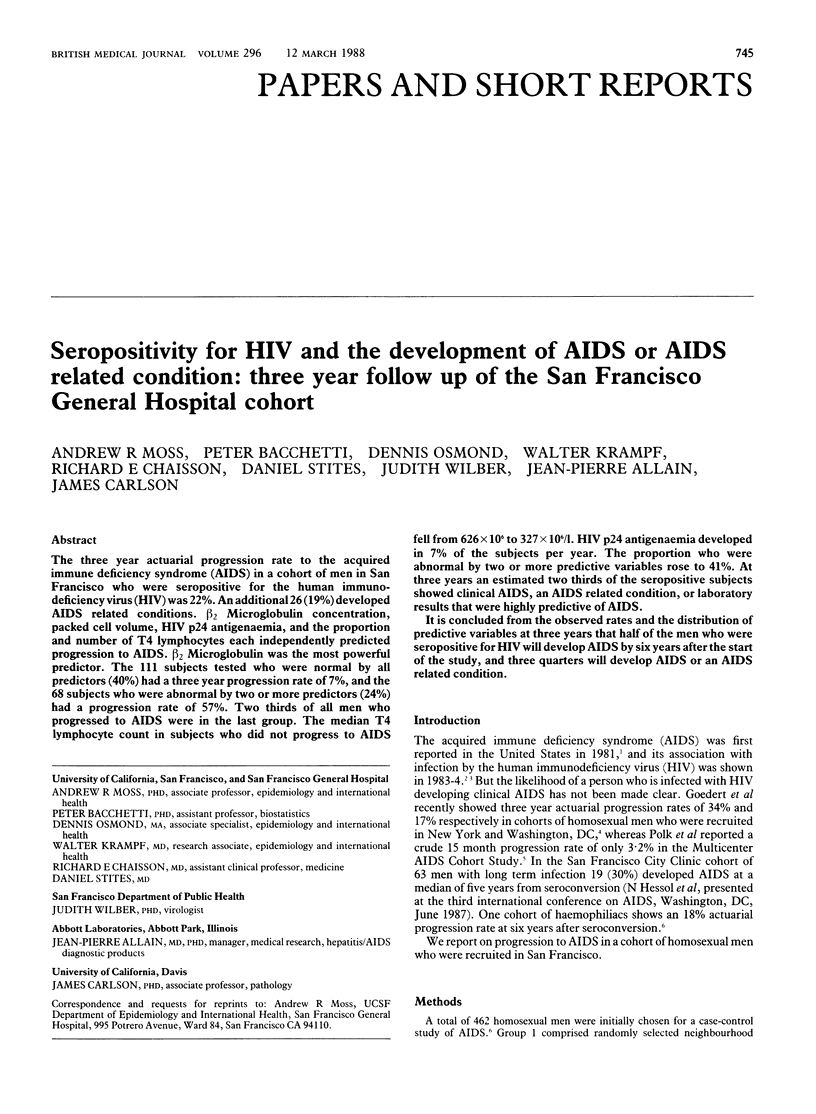
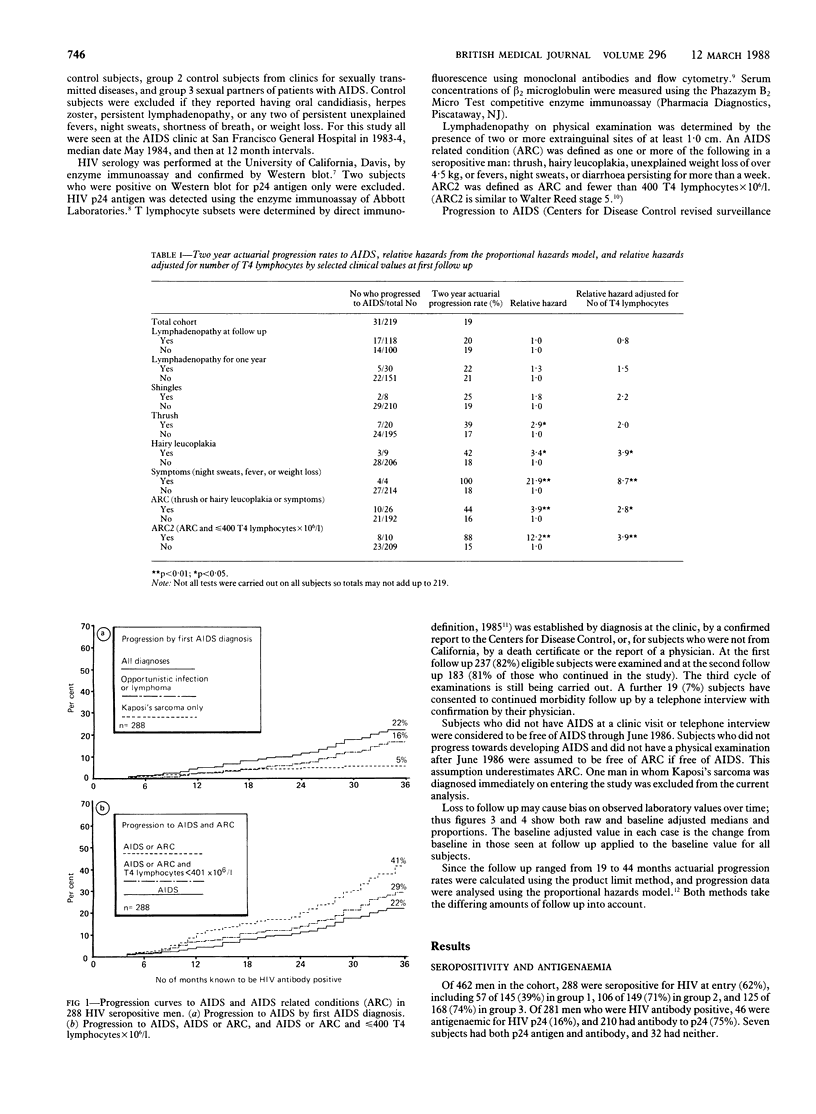
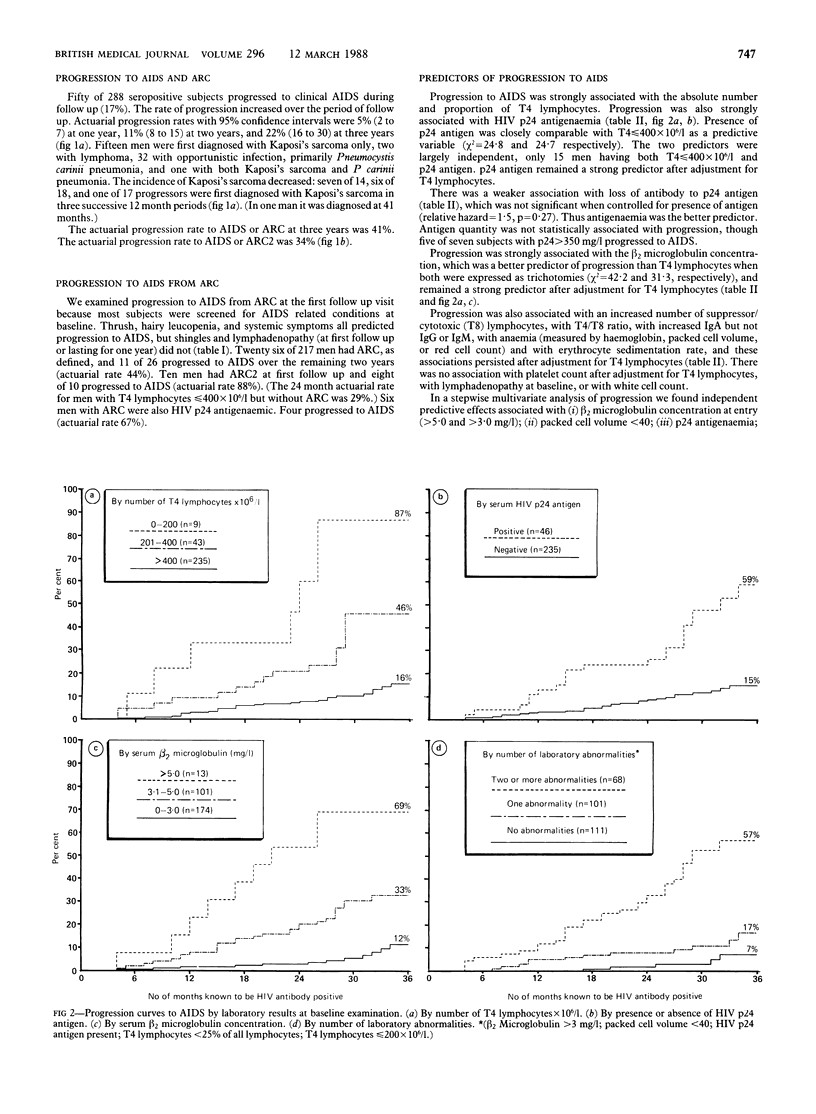
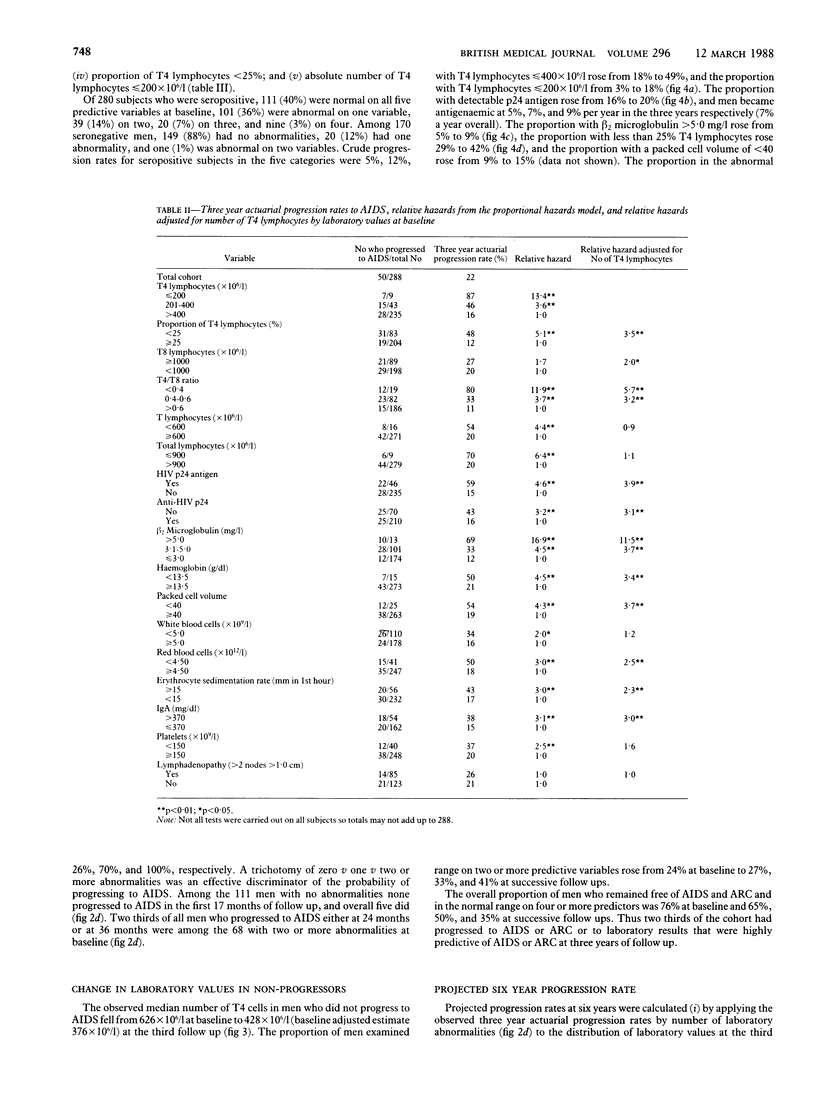
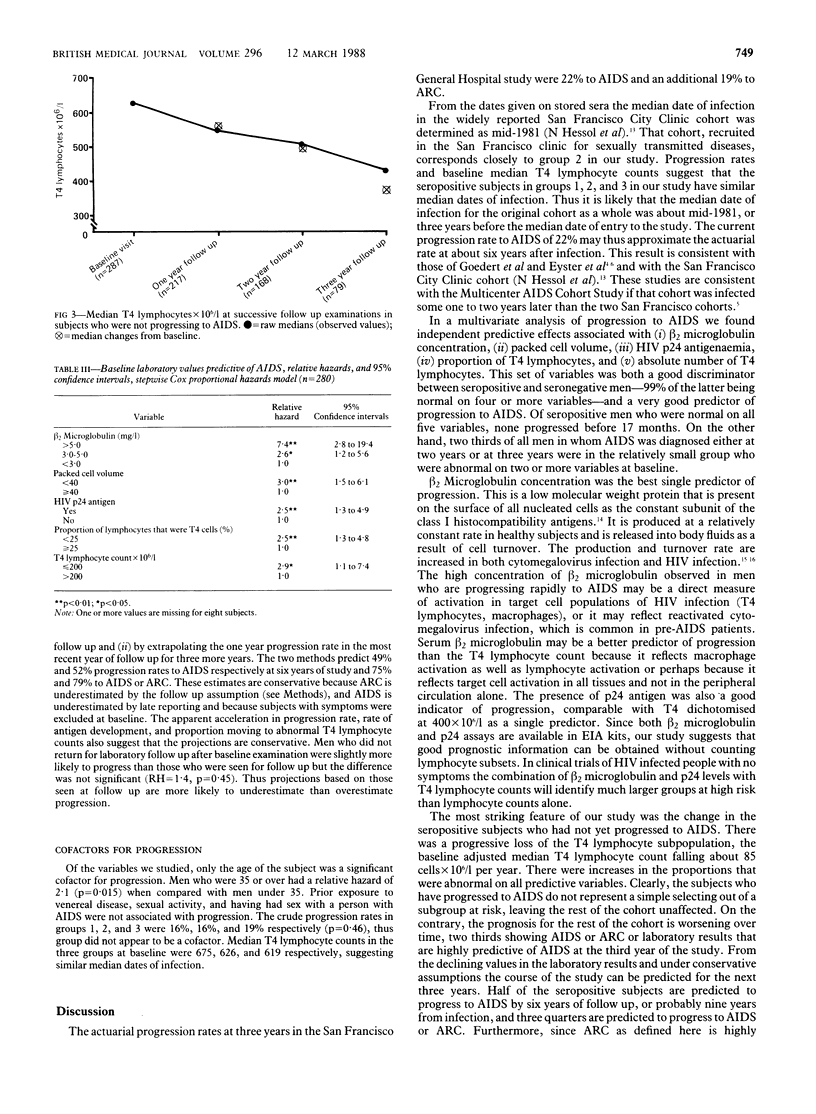
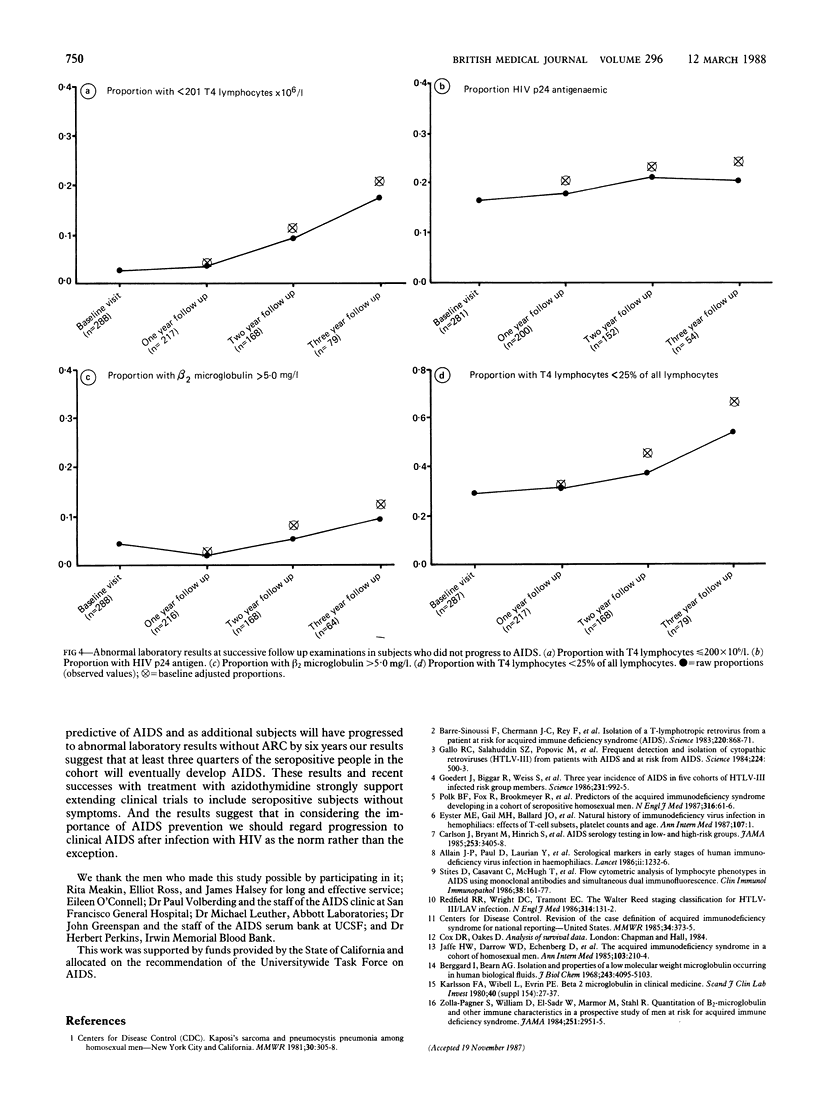
Selected References
These references are in PubMed. This may not be the complete list of references from this article.
- Barré-Sinoussi F., Chermann J. C., Rey F., Nugeyre M. T., Chamaret S., Gruest J., Dauguet C., Axler-Blin C., Vézinet-Brun F., Rouzioux C. Isolation of a T-lymphotropic retrovirus from a patient at risk for acquired immune deficiency syndrome (AIDS). Science. 1983 May 20;220(4599):868–871. doi: 10.1126/science.6189183. [DOI] [PubMed] [Google Scholar]
- Berggård I., Bearn A. G. Isolation and properties of a low molecular weight beta-2-globulin occurring in human biological fluids. J Biol Chem. 1968 Aug 10;243(15):4095–4103. [PubMed] [Google Scholar]
- Carlson J. R., Bryant M. L., Hinrichs S. H., Yamamoto J. K., Levy N. B., Yee J., Higgins J., Levine A. M., Holland P., Gardner M. B. AIDS serology testing in low- and high-risk groups. JAMA. 1985 Jun 21;253(23):3405–3408. [PubMed] [Google Scholar]
- Centers for Disease Control (CDC) Kaposi's sarcoma and Pneumocystis pneumonia among homosexual men--New York City and California. MMWR Morb Mortal Wkly Rep. 1981 Jul 3;30(25):305–308. [PubMed] [Google Scholar]
- Centers for Disease Control (CDC) Revision of the case definition of acquired immunodeficiency syndrome for national reporting--United States. MMWR Morb Mortal Wkly Rep. 1985 Jun 28;34(25):373–375. [PubMed] [Google Scholar]
- Eyster M. E., Gail M. H., Ballard J. O., Al-Mondhiry H., Goedert J. J. Natural history of human immunodeficiency virus infections in hemophiliacs: effects of T-cell subsets, platelet counts, and age. Ann Intern Med. 1987 Jul;107(1):1–6. doi: 10.7326/0003-4819-107-1-1. [DOI] [PubMed] [Google Scholar]
- Gallo R. C., Salahuddin S. Z., Popovic M., Shearer G. M., Kaplan M., Haynes B. F., Palker T. J., Redfield R., Oleske J., Safai B. Frequent detection and isolation of cytopathic retroviruses (HTLV-III) from patients with AIDS and at risk for AIDS. Science. 1984 May 4;224(4648):500–503. doi: 10.1126/science.6200936. [DOI] [PubMed] [Google Scholar]
- Goedert J. J., Biggar R. J., Weiss S. H., Eyster M. E., Melbye M., Wilson S., Ginzburg H. M., Grossman R. J., DiGioia R. A., Sanchez W. C. Three-year incidence of AIDS in five cohorts of HTLV-III-infected risk group members. Science. 1986 Feb 28;231(4741):992–995. doi: 10.1126/science.3003917. [DOI] [PubMed] [Google Scholar]
- Jaffe H. W., Darrow W. W., Echenberg D. F., O'Malley P. M., Getchell J. P., Kalyanaraman V. S., Byers R. H., Drennan D. P., Braff E. H., Curran J. W. The acquired immunodeficiency syndrome in a cohort of homosexual men. A six-year follow-up study. Ann Intern Med. 1985 Aug;103(2):210–214. doi: 10.7326/0003-4819-103-2-210. [DOI] [PubMed] [Google Scholar]
- Karlsson F. A., Wibell L., Evrin P. E. beta 2-Microglobulin in clinical medicine. Scand J Clin Lab Invest Suppl. 1980;154:27–37. [PubMed] [Google Scholar]
- Redfield R. R., Wright D. C., Tramont E. C. The Walter Reed staging classification for HTLV-III/LAV infection. N Engl J Med. 1986 Jan 9;314(2):131–132. doi: 10.1056/NEJM198601093140232. [DOI] [PubMed] [Google Scholar]
- Stites D. P., Casavant C. H., McHugh T. M., Moss A. R., Beal S. L., Ziegler J. L., Saunders A. M., Warner N. L. Flow cytometric analysis of lymphocyte phenotypes in AIDS using monoclonal antibodies and simultaneous dual immunofluorescence. Clin Immunol Immunopathol. 1986 Feb;38(2):161–177. doi: 10.1016/0090-1229(86)90135-2. [DOI] [PubMed] [Google Scholar]
- Zolla-Pazner S., William D., El-Sadr W., Marmor M., Stahl R. Quantitation of beta 2-microglobulin and other immune characteristics in a prospective study of men at risk for acquired immune deficiency syndrome. JAMA. 1984 Jun 8;251(22):2951–2955. [PubMed] [Google Scholar]


